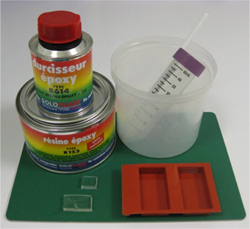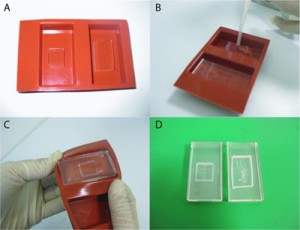André Estévez-Torres, Ayako Yamada and Li Wang
Department of Chemistry, Ecole Normale Superieure, Paris, France.
Why is this useful?
To create microfluidic patterns on PDMS one usually pours PDMS on a mould composed of microfabricated resist features on top of a Si or glass wafer. However, these resist moulds are fragile and usually break after a few uses, making it necessary to perform microfabrication again. Transferring the microfabricated features to an epoxy mould conserves the resolution down to 1 µm[1] and allows: i) multiple and inexpensive copies of the mould, ii) hundreds of uses without significant ageing, iii) easy incorporation of macroreservoirs to the PDMS device without needing to punch them every time, and iv) isopropanol cleaning, which is not possible with AZ resists.
What do I need?
- Resist mould
- PDMS
- Silicone cake mould (e.g. SF025 financiers) from Silikomart (Mellaredo di Pianiga, Italy)
- Epoxy resin (type R123, Bisphenol A/F epoxy resin) and hardener (type R614) from Soloplast-Vosschemie (Saint Egreve, France) or EasyCast Clear Casting Epoxy from Castin’Craft, Environmental Technology[2]
- Trichloromethylsilane
- Plasma cleaner
How do I do it?
1. Pour PDMS on the resist mould and cure it as you usually do.
2. Peel off the PDMS layer from the resist mould. Punch the macroscopic reservoirs if you need them. This PDMS part will be called PDMS master.
3. Put the PDMS master (microfabricated features on top) on the bottom of the silikomart cake mould. You may clean it with 3M tape.
4. Prepare the epoxy mixture as recommended by the manufacturer and remove the bubbles by vacuum pumping or ultrasonication.
5. Pour the epoxy mixture on the cake mould containing the PDMS master until you cover it with 2-3 mm of epoxy. Be careful to avoid making bubbles. If you are moulding small features you probably need to remove bubbles by vacuum pumping.
6. Wait for 24h at room temperature.
7. Remove the epoxy+PDMS brick from the mould and then peel off the PDMS master from the epoxy using a scalpel and tweezers. It peels off very easily.
8. The epoxy mould may be a little soft at this stage. Bake it in an oven at 70°C for one day – it becomes softer – and let it harden at room temperature for another day.
9. Silanize the epoxy mould by keeping it in a closed petri dish with a trichloromethylsilane-saturated atmosphere for 5 min. The first time you use the epoxy mould to make a PDMS device you need to put it into a plasma cleaner before silanization.
10. Pour PDMS on the epoxy mould as you usually do with other moulds. Cure it in the oven following your favourite recipe and peel it off. The first peel off needs to be performed slowly and carefully. Subsequent peelings off are straightforward.
References
[1] This type of technique, called replica moulding, has been reported to yield features down to 100-50 nm (Y. Xia et al., Replica moulding using polymeric materials: A practical step toward nanomanufacturing, Adv. Mater., 1997, 9, 147-149).
[2] http://www.eti-usa.com













